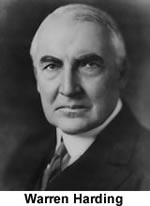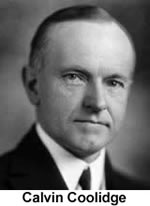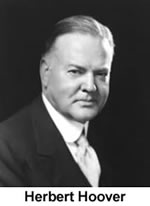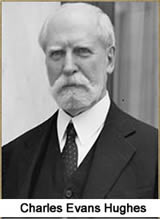Politics in the 1920s
 |
 |
 |
Grover Cleveland and Woodrow Wilson were the only Democratic presidents elected between Abraham Lincoln in 1860 and Franklin Roosevelt in 1933. It is likely that a Republican—either incumbent President Howard Taft or former President Theodore Roosevelt—would have won in 1912 instead of Wilson had the party not divided between Taft’s conservative Republicans and Roosevelt’s Progressives. Wilson defeated New York Governor Charles Evans Hughes in 1916 largely on the fact that he had managed to keep the United States out of World War I.
During Wilson’s second term, of course, the United States did enter the war, President Wilson went to France to help negotiate the Treaty of Versailles, and a bitter fight erupted between Wilson and the Republican Senate over ratification of the Treaty of Versailles. Wilson’s stroke, which he suffered on a cross country campaign trip to drum up support for the treaty, incapacitated him, and his presidency ended on an unfortunate note.
The 1920 Election. The election of 1920, therefore, was as much about President Wilson's legacy as about anything. The Republican candidate, Senator Warren Gamaliel Harding of Ohio, called for a return to “normalcy,” a word he invented for the occasion. His vice presidential candidate was Governor Calvin Coolidge of Massachusetts, who was best known for ending the Boston police strike of 1919. During the strike Coolidge sent a telegram to Samuel Gompers, president of the American Federation of Labor, saying, “There is no right to strike against the public safety by anyone, anywhere, any time.”
The Democrats nominated Governor James M Cox of Ohio, meaning that the “Mother of Presidents” would have seen another one of its sons elected, no matter who won. As it turned out, the 1920 election resulted in a Republican landslide. Harding and Coolidge won 16,152,200 popular votes and 404 electoral votes compared with the Cox-Roosevelt totals of 9,147,353 popular votes and 127 electoral votes. Most memorable about the election of 1920 is that for the first time women had the right to vote. (The fact that women could vote probably had little impact on the outcome of the election; analysis has shown that in the early days of women's suffrage, most women voted with their husbands or fathers.) On the Democratic side another interesting note is that Franklin Roosevelt, President Wilson’s assistant secretary of the navy, was the vice presidential candidate alongside Governor James M. Cox of Ohio, a former newspaperman. Realizing early that Governor Cox had little chance to win, Roosevelt traveled widely across the country campaigning, thus building up a base of support for his future political career. As one wag put it, “He ate a lot of chicken and peas.”
President Harding. Harding’s presidency is not one of the high points in the history of that office. Phrases used to describe the handsome man from Ohio included “harmless but incompetent,” “pompous,” and a “see-nothing president.” He had several good cabinet officials, including Charles Evans Hughes as Secretary of State, Pittsburgh banker Andrew W. Mellon, one of the richest men in the country as Secretary of the Treasury and Herbert Hoover as Secretary of Commerce. Other appointments were less able: Harding's administration was tainted by corruption, as was his personal conduct. (Although evidence is murky, it is clear that he had extra-marital affairs.) Upon his death in 1823 he was initially mourned, but as the scandals emerged, people found Calvin Coolidge a pleasant relief.
President Harding left foreign policy in the hands of Secretary of State Hughes. The first order of business was settling peace with Germany and Austria, which occurred in 1921. Another major issue was the huge amount of debt owed to the United States from loans made during the war. Efforts were made to  reduce the burden of debt, but when the worldwide depression arrived, much of that debt was defaulted. Secretary Hughes also wanted to follow a policy of international military disarmament. A conference was convened in Washington in November 1921. At the opening of the conference, Secretary Hughes made a speech calling for radical reductions in the number of warships by the participating nations. Hughes also worked hard to improve relations with the Latin American nations, withdrawing troops from Cuba and settling some outstanding issues with Mexico.
reduce the burden of debt, but when the worldwide depression arrived, much of that debt was defaulted. Secretary Hughes also wanted to follow a policy of international military disarmament. A conference was convened in Washington in November 1921. At the opening of the conference, Secretary Hughes made a speech calling for radical reductions in the number of warships by the participating nations. Hughes also worked hard to improve relations with the Latin American nations, withdrawing troops from Cuba and settling some outstanding issues with Mexico.
The presidency of Calvin Coolidge has been identified by the phrase “Coolidge prosperity.” Although the ’20s themselves were a raucous decade, in one sense things were returning to normal after the activism of Theodore Roosevelt and the international involvement of the idealistic Woodrow Wilson. Led by pioneering businessmen such as Henry Ford, the American economy moved forward vigorously, and President Coolidge was credited with doing little or nothing, which, as Will Rogers remarked, was exactly what the American people wanted. Although Coolidge’s White House was open to visitors, Coolidge himself, was known as “Silent Cal,” because he had little to say. On one occasion a woman visitor gushed, “Mr. President, I bet a friend that I could get at least three words out of you!” Coolidge’s response: “You lose.”
The 1924 election was notable for several things. The Democratic Party was in disarray and needed 103 ballots to nominate its candidate, Governor John Davis of West Virginia, at the 1924 convention in New York City. The Progressive Party, still alive and well, nominated Robert LaFollette, who wound up with a respectable 4.8 million votes in the general election. President Coolidge ran on an essentially conservative platform, promising to maintain the status quo. Coolidge’s victory was not as impressive as Harding’s, but he won by a comfortable margin. The results were as follows:
| Republican | Coolidge | 15.7 million votes | 382 Electoral Votes |
| Democrat | Davis | 8.4 million | 136 |
| Progressive | La Follette | 4.8 million | 13 |
| Other | Note: The Workers Party (Communist) gets 33,000 votes. | ||
President Coolidge. The American economy boomed during Coolidge's presidency, which gave rise to the phrase the “Roaring Twenties.” Commerce Secretary Hoover helped promote business growth, allowing the economy to grow without undue government interference. In a speech to newspaper editors Coolidge said that, "the chief business of the American people is business," and his administration supported that end. Labor and workplace safety issues were left for the states to deal with. Secretary Mellon oversaw policies that resulted in the reduction of taxes, while at the same time federal spending was limited. Secretary Hoover also encouraged the modernization of agriculture.
On the issue of civil rights, President Coolidge granted citizenship to Native Americans living on reservations. He spoke at Howard University and thanked African-Americans for their contributions to American society. He also expressed his appreciation to immigrants for what they had contributed to the country saying that they had helped make the country what it is.
The 1928 Election. As the 1928 election approached, President Coolidge announced that he did not choose to run for reelection. The nomination easily went to Secretary of Commerce Herbert Hoover, a self-made millionaire and businessman from Iowa whose managing of food relief for Europeans during the First World War had gained him much public admiration. Although he had never held elective office, his fundamental honesty and calm demeanor made him an attractive candidate.
On the Democratic side, Governor Al Smith of New York was nominated following a rousing nomination speech by Franklin Roosevelt, a public appearance that helped resurrect his political career following his bout with polio. Governor Smith was Roman Catholic and “wet”; that is, he favored repeal of Prohibition. The election saw the forces of intolerance out in full, as many Americans, especially in the South, were not ready to see a Catholic elected president. In addition, Governor Smith was thought to be a machine politician from New York, and his New York City accent sounded strange to many during his radio addresses. The voice of the Ku Klux Klan, which had reemerged during the 1920s, is believed to have been a factor in opposition to Governor Smith. Hoover actually won some southern states, who had been fiercely democratic since the Civil War, because of the religion issue.
The results:
| Republican | Hoover | 21 million votes | 444 Electoral Votes |
| Democrat | Smith | 15 .4 million | 87 |
An interesting side note is that although Governor Smith lost the election by a wide margin, Franklin Roosevelt, politically resurrected following his bout with polio, was comfortably elected governor of New York. The results in 1928 gave 21 million popular and 444 electoral votes to Hoover, whereas Governor Smith got 15.4 million popular and 87 electoral votes, another Republican landslide. In any event, President Hoover cracked the so-called “solid South,” which since Reconstruction had voted almost exclusively Democratic. Hoover won some southern states because of the religion issue.
In his inaugural address, President Hoover expressed confidence in the future of America:
Ours is a land rich in resources; stimulating in its glorious beauty; filled with millions of happy homes; blessed with comfort and opportunity. In no nation are the institutions of progress more advanced. In no nation are the fruits of accomplishment more secure. In no nation is the government more worthy of respect. No country is more loved by its people. I have an abiding faith in their capacity, integrity and high purpose. I have no fears for the future of our country. It is bright with hope.
President Hoover wanted to assist farmers who had suffered during the 1920s, and in nineteen thirty he signed the controversial Smoot–Hawley Tariff Act. The act was meant to encourage Americans to buy homemade products by raising the cost of imports, with the growing worldwide depression resulted in retaliation by other nations, which worsened worldwide economic conditions. Hoover also favored balancing the federal budget, and he raised tax rates on the wealthier segment of the population significantly. (President Hoover's economic policies will be discussed further in the next section on the Great Depression.)
In March 1929 President Hoover had good reason to feel optimistic, but it was clear that storm clouds were already visible on the horizon. President Hoover was a brillian engineer adn self-made millionaire, but his financial policies wer not attuned to the coming economic disaster. as a conservative, he believed that market forces wouod correct the problems of the Depression, but in time he did take measures designed to alleviate the crisis. It was far too little.
| Sage History Home | Twenties & Depression Home | The Crash of 1929 | Updated April 25, 2017 |